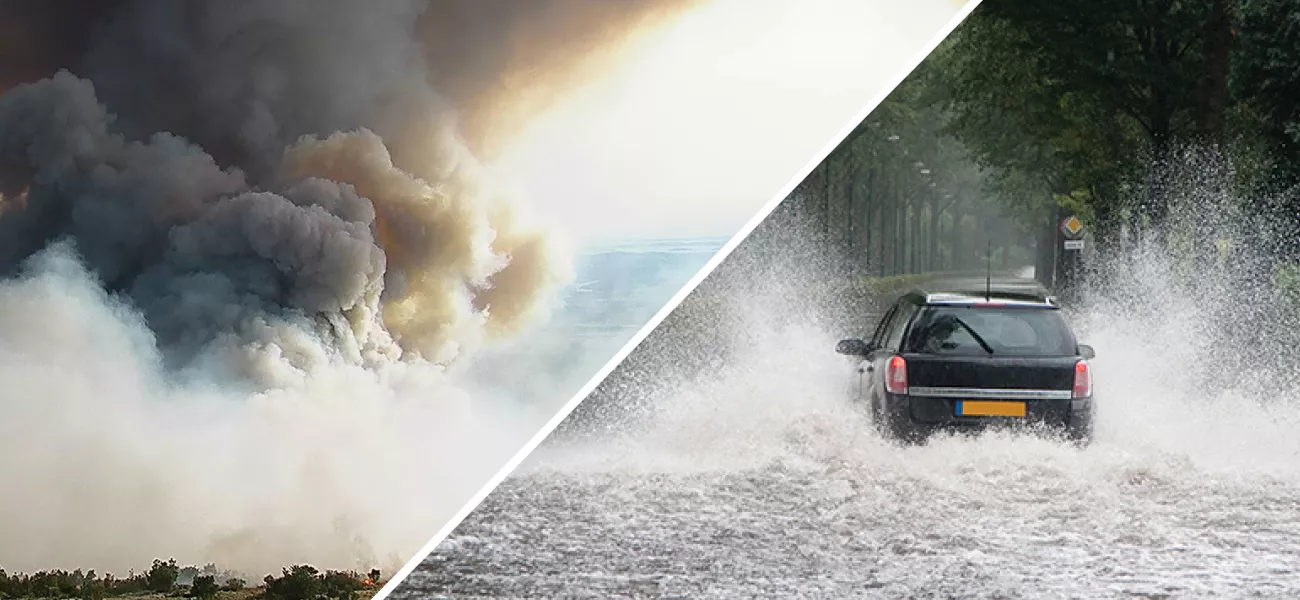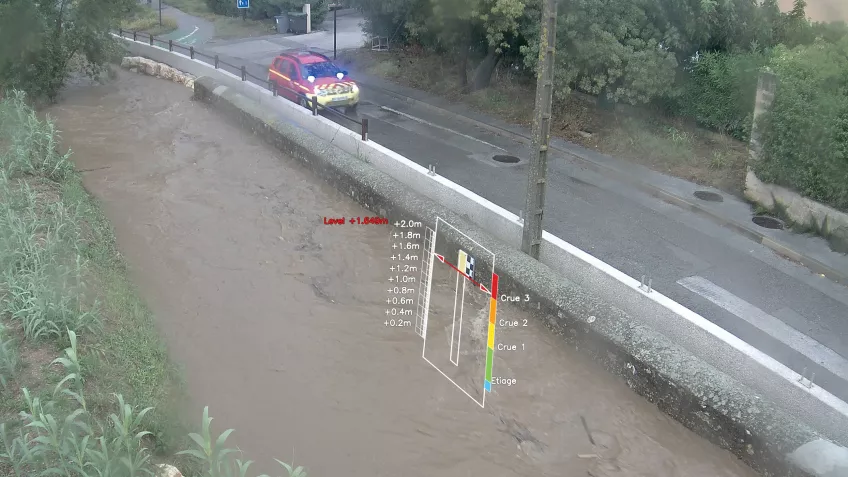
Video surveillance, while typically associated with security, is increasingly being used for other use cases. For instance, we’re increasingly seeing video surveillance being used for safety purposes. This is to help mitigate unintentional dangers and incidents that can cause harm to people, property, and the environment.
One of the reasons for this rise in safety usage is due to the impact of climate change. Extreme weather has been and will always be a facet of the modern world, whether it be snowstorms, hurricanes bringing high winds, flooding caused by heavy rain, or wildfires spreading through forests during periods of searing high temperatures. In recent times, the ferocity of these events appears to be increasing, posing a real threat to the safety of people and wildlife.
Although these events cannot be prevented, detecting early warning signs and subsequently acting quickly to put safety measures in place can limit damage and improve survival rates.
This blog post explores how video surveillance can be used to monitor and act upon extreme weather, with particular focus on flooding and wildfire use cases.
Security cameras for early detection – and increased safety
Extreme weather is almost inevitable, but it’s important to consider what preventive measures you can put in place to help mitigate the impact.
Video surveillance, environmental sensors, and analytics are being increasingly used by authorities to give early warning of potential disasters and support the most rapid and effective response. More specifically, security cameras can be used to monitor high risk areas, collect real-time weather data and generate automatic warnings for specific changes that may signal the advent of an extreme event.
This early detection can be critical. One of the most dangerous elements of extreme weather is how quickly it can arise, change and worsen. This is especially true for storms and tornadoes such as the deadly Kentucky tornado outbreak. As with this tragedy, these can hit unsuspectingly in at-risk urban areas, and can lead to significant loss of life. The best way to mitigate this is to understand exactly how areas may be affected and implement changes to help anticipate them.
Yet, this can be difficult to determine. It often requires an extreme weather event to have occurred for an area to understand the risks posed – but no two events are the same. This is where integrating real-time weather information with video surveillance systems and analytics can help.
Placing security solutions in certain, high-risk areas can provide footage of events and key insights into where extra support is required. Using this data, you can better understand the measures needed and implement appropriate changes to better prepare for future incidents.
Flooding puts residents’ safety at risk
One of the most critical threats that can occur in an urban environment is flooding. Following periods of heavy rainfall, drainage systems can quickly become overwhelmed, leaving key routes impassable, causing damage to infrastructure and threatening lives.
Security cameras and IoT sensors can help to monitor areas which are prone to flooding and alert officials once a pre-determined threshold is met. This allows measures to be quickly put in place, from communicating the crisis with affected communities via loudspeaker or text message to arranging evacuation, if needed. Acting quickly can help remove people from immediate danger and enable emergency teams to re-route traffic, restrict access to dangerous areas and manage the situation as it develops.
For example, Météo-France’s Flood Forecasting Service (SPC) monitors waterways in flood-prone areas. By monitoring and measuring factors such as rainfall and groundwater, as well as observation across underwater flow sensors, experts can identify when flooding is likely to occur. But it can be tricky to obtain these readings accurately. As part of a broader solution, security cameras are used to capture images which helped measure the water height and surface flow speed at certain areas in the SPC East Mediterranean waterways. This enables officials to continuously monitor the area, ensuring that they are able to respond to any critical alerts quickly.
Similarly, following floods in Greater Toulon Provence Mediterranee, local public safety authorities and the river guilds made a commitment to improve knowledge and awareness of flood risks by providing prevention and warning tools. The real-time information system for monitoring the waterways with cameras at the region’s main watersheds has enabled true surveillance of waterways in real time and allowed public safety authorities to take action when a risk is detected.

Using security cameras to help monitor and mitigate wildfires
Another natural disaster which can arise and spread quickly is a wildfire. Following periods of high temperatures, they can pose a significant risk. This can be seen in the record-setting 2020 wildfires that spread across California, Oregon and Washington in the US, and in the more recent 2023 fires that took hold in Rhodes, Greece. The potential impact of these uncontrolled fires cannot be underestimated. According to reports, the 2020 wildfires in the US alone cost insurers between $7 billion to $13 billion in damage.
These fires threaten both wildlife and residents. They’re often difficult and dangerous to contain, due to the scale of land affected. Wildfires may rage on for extended periods of time, outpacing efforts to control the spread. It’s also worth remembering that the effects aren’t confined to the immediate areas. Fires around cities can have a dangerous effect on the air quality for citizens. Understanding and pinpointing ignition sites and monitoring conflagrations and air quality can provide emergency teams with vital information, enabling them to make key decisions quickly.
This was certainly the case for ALERTWildfire, a monitoring organisation based in the US. Officials wanted to deploy high quality camera technology in forested areas to help firefighters and the public spot fire ignitions before they burst into full-fledged conflagrations. Working with Professional Telecommunications Services (PTS), security cameras were used as sensors to monitor for any flare ups in remote areas and provide location information so firefighters could address fire activity early. The cameras also allowed emergency services to monitor situations as they progressed, which helped to inform further decisions and provide updates to the affected communities and wider public.
Meanwhile, numerous fires have threatened the Oasis territory of Italy in recent decades. However, prevention activity has since taken place with the installation of smart cameras and gateways for timely detection. Following this project, one of the security cameras detected a plume of smoke caused by the burning of plant residues (olive branches) at the borders of the Oasis, but no fires have occurred given the cameras have allowed for timely intervention. Smoke detection for outdoor environments is also enabled by the Waterview smoCAM. This video analytics solution can detect smoke plumes as well as provide an estimation of the distance of a plume from the camera itself.
Another inspiring story is the early wildfire detection for Big Tree Animal Sanctuary and Adoption Center by RoboticCats in Hong Kong. The center is located in an area which is susceptible to wildfires, especially during the period of Ching Ming Festival and Chung Yeung Festival. Following a fire incident which fortunately did not result in loss of life, the center implemented a video surveillance solution to help staff members monitor the premises remotely. In this way, early signs of fires could be detected, and action taken to immediately evacuate animals and staff safely.
Since 2021, RoboticCats has also deployed Wildfire Detection software in wind power farms with the goal of detecting early-stage wildfire outbreaks nearby. This technology protects both the facilities and surrounding communities from forest fires.
Preparing for better future outcomes
Extreme weather will continue to be a fact of life, potentially intensifying with time. As a result, it’s critical to be prepared to react quickly in real-time and plan for future events in high-risk areas. The aim is for these incidents to be mitigated or mitigated in the early stages, reducing the impact on life and property.
The security industry as a whole is continuing to grow more and more in addressing safety for extreme weather conditions, but already we can see the key role video surveillance technology plays in arming emergency services with the information they need to make critical life-preserving decisions. By installing security cameras in key places, insights gained can help mitigate the impact in the short and long term, leading to better outcomes.
